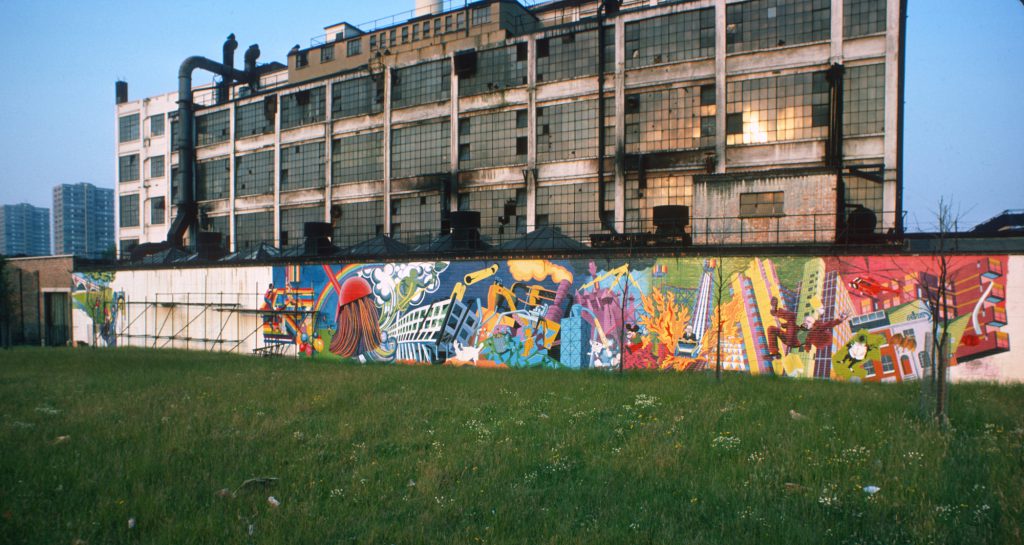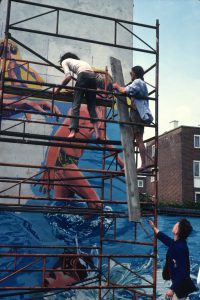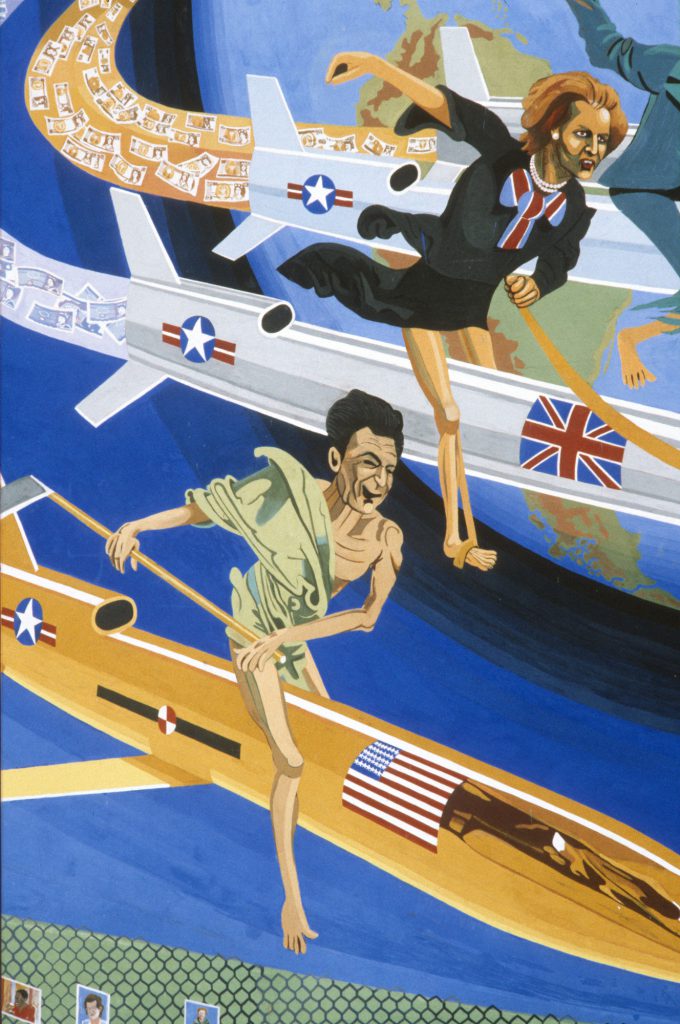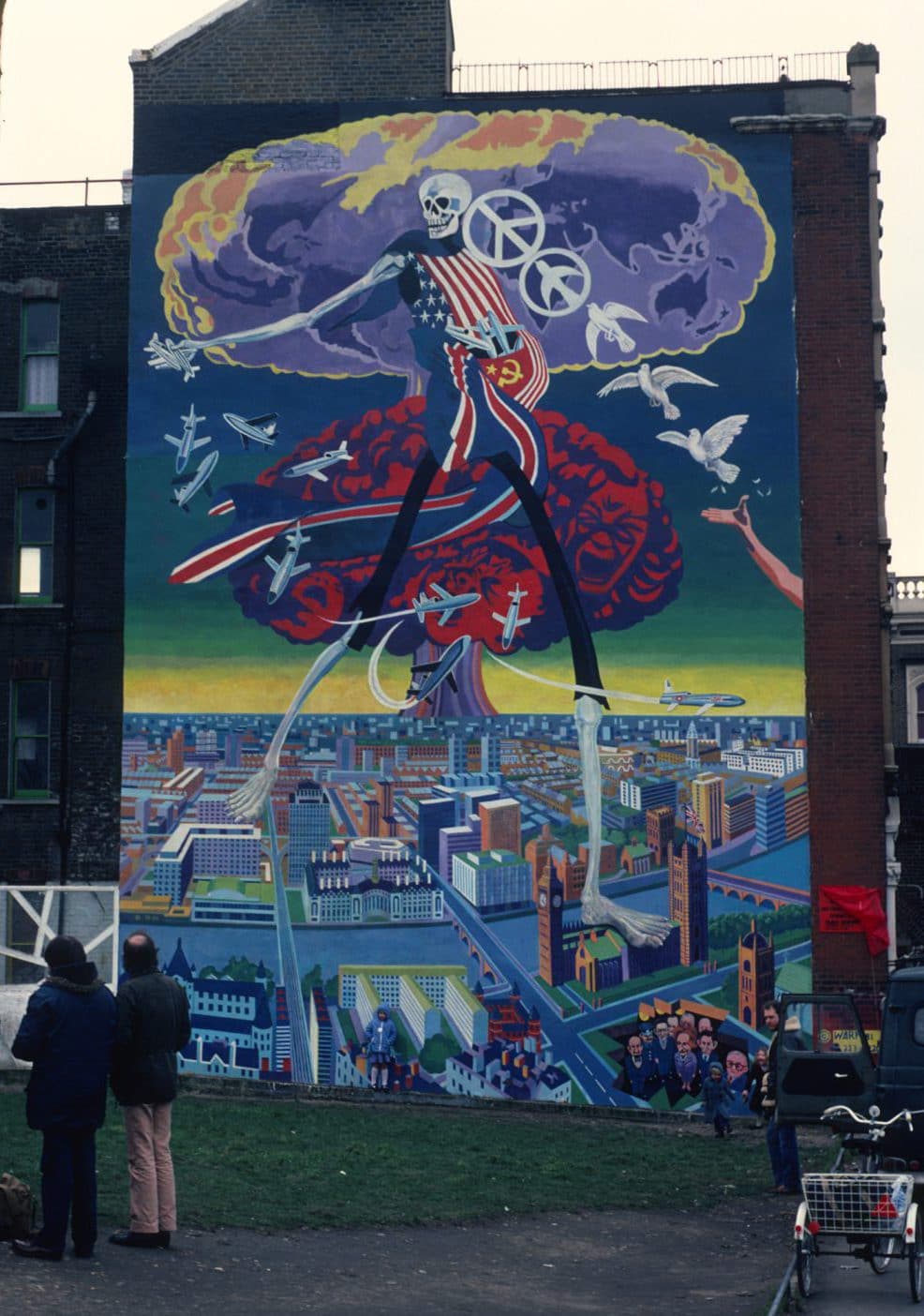The Wandsworth Mural Workshop was founded by Brian and Aileen Barnes in 1976
They had met at Ravensbourne College of Art; Aileen in her first year coming down from Lincolnshire to study fashion, Brian in his last year was studying painting, up from Kent. He had a flair for drawing from youth, encouraged by parents and teachers, and started at the College when he left school at sixteen. He had a facility to draw and paint figures and landscapes very confidently and accurately,
“I was one of the ultra realists,” he says, “my mentors were Michelangelo, Botticelli and Leonardo, I never got much further than the Renaissance!”
art at school
After 4 years at Ravensbourne and having achieved his National Diploma in Design (NDD), Brian was offered a place to study painting at the Royal College of Art. He found themes to paint outside the current fashion, painting detailed landscapes from the College attic and in its greenhouse.
Brian at the Royal College
The young couple lived close by, in spartan rooms over a shop, across the river in Battersea, and it was here they raised two children and became part of the cosmopolitan working-class milieu. After College Brian recalls, “I had to do a lot of ducking and diving”, doing a lot of part-time jobs until he found a post at a large secondary school, teaching woodwork and metalwork, before being moved to something he really knew, teaching art; and soon and he began to work with the pupils on playground murals and decorating buses.
Tulse Hill School
He and Aileen became part of Battersea Redevelopment Action Group (BRAG) whose aim was challenge the Wandsworth Council’s housing policy of building for the wealthy, advocating instead community action to occupy abandoned sites to build affordable homes and create public spaces. Brian began making posters for BRAG and other community groups, and was given a grant by The Gulbenkian Foundation for £2000; and formally became Community Artist in Residence. When BRAG created a public park in front of Morgan’s abandoned factory close by Battersea Bridge, Brian was asked to paint a mural on its perimeter wall, eighteen feet high and a hundred and fifty feet long.
‘The Good the Bad and the Ugly’

‘The Good the Bad and the Ugly’ was designed in several sections; to the left was the good side with allotments, gardens, house building and play spaces, in the centre a giant rainbow-bristled broom swept away to the left all that was bad into flames, the Corporations, the councillors and developers and their visions of a shiny city on the riverside. The wall took several months to complete, ninety people helped, and it became famous, being on a main artery into the city, so intense in colour and so strong its message. When the embittered site owners one night eight months later felled the wall with bulldozers there was an outcry, a huge demonstration. Battersea Bridge was closed as Brian battled to stop the destruction. A vindictive prosecution by the police was thrown out. “It was the greatest act of vandalism I’ve ever seen” said a witness.
When the pair were rehoused on a council estate off Thessaly Road in Battersea, Aileen and women from their residents association lobbied the Greater London Council (GLC) to give a grant to recreate a park for the estate on a nearby disused site. As it neared completion another gable end fronting the park came in view, and a mural was planned with the theme of tenants themselves; to be called ‘A Day at the Seaside’.
a day at the seaside

There was a coach outing to Southend where everyone took photographs as they played on the beach and in the sea – pictures which which Brian then used to design the mural. The wall was prepared, primed and drawn up, then painted by Brian assisted by Aileen and the architect, film-maker and squatting activist Dale McCrea. It took a year to complete through a bitter Winter in 1978.
‘Nuclear Dawn’
Soon after this Dale got a lease on a big Victorian block in Brixton to set up a housing association for young people. He said to Brian, “Its got a big wall on it so we should paint a mural, and I have bought a cradle.” No consent was needed but a planning officer warned them: “You realise you are painting in the council’s airspace.” Set beside a busy thoroughfare this could not be community inspired event as the seaside mural had been, so Brian talked it through with the new tenants of the house. Threat of Nuclear War was the theme they chose. Dale had discovered a giant skeletal figure by Félician Rops and Brian drew it crossing London, spreading disaster; showing the great buildings of state and religion in the foreground and politicians hiding in a bunker below. Through the Winter they primed and drew the image from off the rickety cradle, then began the image from the middle down, commenting, “If we fall down from here there’s a chance we’ll survive.” Painting the sky followed with its mushroom clouds, missiles and doves, then when the rest of the wall could be reached from ground level, more people volunteered to paint.
For muralists in this period, finding the finance for projects was always difficult. Sometimes they worked project by project, putting together single grants that were raised ‘ducking and diving’, trying different strategies, searching for new sources. Other times they received revenue funding which allowed them the opportunity to plan ahead, to employ people for two or three years ahead. Towards the end of this period when the Conservatives came to power, austerity gripped the arts and communities, it was more difficult for Wandsworth Mural Workshop (WMW) to pay other artists or subsidise the production of posters, and people had to be laid off. The artist Christine Thomas had joined the group when it was well funded and painted two decorative and optimistic murals that were well received. When WMW’s funding was cut, a dispute over who should leave, split the group, with Brian remaining and Christine setting up separately as Wandsworth Arts.
In 1981 Labour took control of the GLC, and shortly after a coup created a radically left-wing administration. Tony Banks, its deputy leader introduced an arts policy which which led to a surge in Ethnic and Community arts. 1983 was designated ‘Peace Year’ and £40K was given to a group of artists calling themselves ‘London Muralists for Peace’ (LMP). During 1983 and 84 six such murals appeared around London and Wandsworth Mural Workshop painted the one in Sandford Place in New Cross. Brian, who had made the initial bid for the money with Dale, became the LMP paymaster and would share out the grant among the muralists as it was received incrementally from the GLC. There were regular meetings of the muralists, sharing ideas and having arguments over the allocation of the money.
‘Riders of the Apocalypse’
 Brian’s next mural called ‘Riders of the Apocalypse’, is based on Durer’s famous drawing, and painted in Keim Paint which is more time consuming to use but has the advantage of a long life. At first the figures were drawn as skeletons but these were thought to be too commonplace. It was agreed they should be replaced with representations of the world leaders of the time: Andropov, Thatcher and Reagan plus Heseletine the UK Minister of Defence; each aggressively circling the planet on a cruise missile. The people of Sandford Place said the mural was just what they wanted. Brian included references to the women’s protest around the American airbase at Greenham Common, painted a wire fence onto the lower part of the mural and copied onto it the resident’s own photographs of loved ones, as women had done on the real fence at Greenham. The mural’s sensational representation of the nuclear threat and scabrous representation of the politicians had inevitable consequences.
Brian’s next mural called ‘Riders of the Apocalypse’, is based on Durer’s famous drawing, and painted in Keim Paint which is more time consuming to use but has the advantage of a long life. At first the figures were drawn as skeletons but these were thought to be too commonplace. It was agreed they should be replaced with representations of the world leaders of the time: Andropov, Thatcher and Reagan plus Heseletine the UK Minister of Defence; each aggressively circling the planet on a cruise missile. The people of Sandford Place said the mural was just what they wanted. Brian included references to the women’s protest around the American airbase at Greenham Common, painted a wire fence onto the lower part of the mural and copied onto it the resident’s own photographs of loved ones, as women had done on the real fence at Greenham. The mural’s sensational representation of the nuclear threat and scabrous representation of the politicians had inevitable consequences.
“Bad move,” said Brian, “I was really naive. This got me on the radar of Special Branch, the Americans, the CIA. The GLA put it on the front of their newsletter and got closed down.”
Now he says that the mural is less shocking, trees have grown around it. The residents have just celebrated its thirtieth birthday, and he would liked to have gone back to do some minor pieces of repainting.
After this mural Brian went on to paint eight or more murals and still continues to design them for his Battersea community. Asked how his work affected his family he admits to being obsessive about his work, says “I hauled them out to help me in all weathers – Aileen says, I live in a world of my own.”
advice to artists considering taking up mural painting
